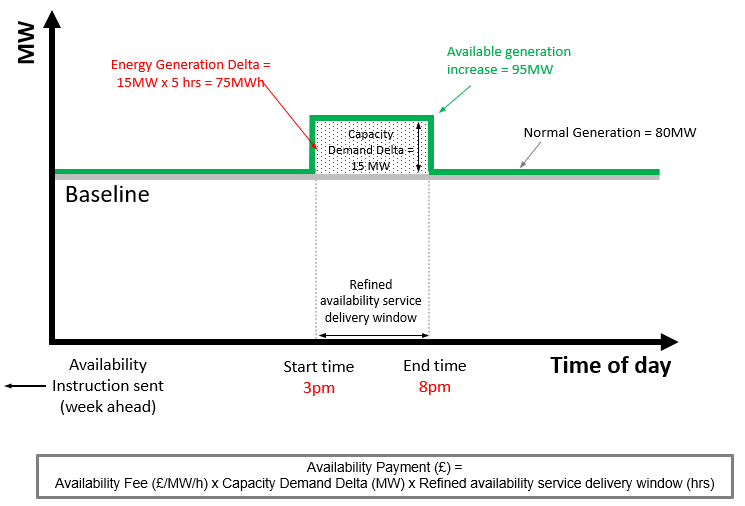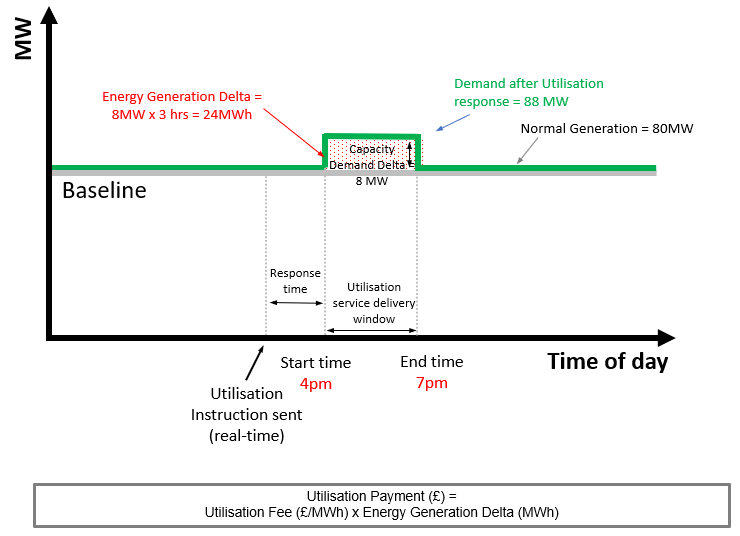Generation case study
Introduction
A dairy farmer is looking to provide flexibility services to Electricity North West through an Operational Utilisation & Variable Availability contract by increasing generation to help reduce the impact of constraints on the network.
About flexibility services
When the demand for electricity is greater than the amount that Electricity North West can provide, we procure flexibility services to alleviate constraints on our network during peak times. These services are provided by companies or individual customers known as flexibility providers, who own assets in our region such as generators, battery storage and electric vehicle (EV) charge points that can generate more or use less electricity during a pre-agreed service delivery window, and can provide a minimum of 10kW either individually or via an aggregator. This allows us to balance supply and demand, ensuring a safe and reliable supply of energy for our customers and in return for providing extra capacity, flexibility providers receive payment from Electricity North West.
Generating renewable energy from animal waste
The farmer will provide an Operational Utilisation & Variable Availability service by using their biomass plant to increase electricity generation upon receipt of instruction from Electricity North West. The farmer's biomass plant generates electricity by converting the manure from 600 dairy cows on the farm, using a retention pond (digester) into renewable natural gas (RNG). Compared to many other renewable energy options, biomass has the advantage of dispatchability, meaning it is controllable and available when needed. Converting animal waste into electricity is cost effective and helps reduce waste going to landfills or from being released as greenhouse gases into the atmosphere.

Pre-tender
Our tenders are published on the ElectronConnect platform twice a year in spring and autumn in line with our Network Development Plan (NDP) and Distribution Future Electricity Scenarios (DFES) publications to reflect our latest network requirements. To be notified of our upcoming tenders, the farmer signs up to our flexibility mailing list.
Prior to the launch of the tender, the farmer:
- Registers the company onto ElectronConnect to pre-qualify to participate. The information submitted such as credit checks and insurance details are assessed by Electricity North West and once approved, the company's commercial qualification remains valid for future tender rounds
- Electricity North West utilises the framework style Standard Flexibility Services Agreement developed by the Energy Networks Association Open Networks Project. The farmer can sign up to the general T&Cs of this agreement as part of commercial qualification, and a signed copy must be returned via Electron prior to placing a bid.
- Registers their asset(s) on ElectronConnect.
Tender process

Pre-qualification
Once the Invitation to Tender (ITT) has been published, the farmer reviews the network's flexibility services requirements using the interactive map on the platform and upon establishing that their farm is located within a requirement zone seeking an Operational Utilisation & Variable Availability service, they calculate how much of the required demand response it can offer, when, and at what price. Prior to submitting a bid, the farmer uses the cost calculator tool on our website to check that the prices they are prepared to offer for availability and utilisation don't exceed the ceiling price that we are offering for the service as part of this tender round. The cost calculator can be found within the ITT appendices. At this point, the farmer has decided they would like to participate in the tender.
Their next step is to complete technical qualificationon ElectronConnect by confirming the assets they wish to put forward in the competition. Electricity North West then assess the technical details of the participating assets and their capability for delivery. If the farmer is unable to provide 10kW of flexible capacity, it can still take part via an aggregator- aggregators such as electricity suppliers, combine load from multiple customers to provide flexible services. The farmer is notified via ElectronConnect that their assets meet the requirements of this tender, allowing them to move to the bidding stage of the process.
Submitting a bid
For the final stage of the procurement process, the farmer submits a bid to the tender. This is carried out by linking the pre-registered assets to the availability and utilisation payments, as well as the periods where the farmer can deliver availability of the response. Once the bidding window has closed, Electricity North West assesses the tender responses before accepting or rejecting bids based on the proposed payment and the asset's ability to meet the specification. If the farmer's bids are successful they will then enter into a flexibility services agreement with Electricity North West to deliver the Operational Utilisation & Variable Availability service within the required service windows.
Helpful tips to consider prior to submitting a bid:
- Prices should be made up of an Availability payment and a Utilisation payment. Availability is the price paid to the farmer even if Electricity North West don’t call on the flexible service and Utilisation is the price paid to the provider for the level of response they have actually provided on request. Note: Electricity North West will not always utilise as much energy as they have requested availability for, there is a level of over procurement built in to ensure that there will be a sufficient response available if required.
- When calculating the tender bid prices the farmer should consider the cost of lost revenues, fuel costs, environmental or permit fees, initial set up costs, maintenance, other revenue streams available, energy savings benefits etc.
- When thinking about the Availability periods the farmer should consider the practicalities of these Availability periods, the processes required to ensure that the service can be delivered, seasonal considerations e.g. major televised events, Christmas period, weather related issues e.g. extreme cold weather increasing heating demand and maintenance periods.
Flexible Service products
Electricity North West procure three common products (services), which align with the Open Networks service definitions:
- Peak Reduction
- Operational Utilisation
- Operational Utilisation & Variable Availability.
The Operational Utilisation and Variable Availability product is used to keep the power flowing during an unplanned network event during maintenance work or network thermal constraints.
The farmer ensures their asset is available to deliver the demand reduction response during the service windows specified in their bid response.
Payment
The Operational Utilisation & Variable Availability product consists of an Availability and Utilisation fee:
- By accepting an Availability fee, the farmer is expected to be ready to respond to Utilisation calls within the agreed response time (15 minutes maximum) during the service window(s). Availability is the price paid to the provider even if Electricity North West don’t call on the flexible service. It is measured in £/MW/h. The availability windows are refined in terms of the required maximum capacity (MW) and period (days & hours) a week ahead each Thursday for the following week (commencing Monday). The farmer will be paid Availability Payments based upon the required availability which following any alterations/refinements to capacity and periods.
- Utilisation payment is awarded on delivery. Utilisation is the price paid to the farmer for the level of response they have actually provided on request. It is measured in £/MWh.
- It should be noted that Availability and Utilisation Fees payable to the farmer under this product are subject to Electricity North West’s actual availability requirements and actual utilisation of the farmer’s flexibility services closer to real-time.
Dispatch
The farmer can choose to receive dispatch instruction via Application Programming Interface (API), email, or Electricity North West owned Remote Terminal Units (RTU).
Worked Example
The farmer has a biomass plant with an installed capacity of 100 MW and has signed an Operational Utilisation & Variable Availability service (demand reduction) contract with Electricity North West.
The farmer can increase the biomass plant generation by up to 20MW, during certain pre-determined time periods. In this example, the pre-determined period is November-February every Mon-Fri between 12am-5am & 5pm-12am. The farmer said they can respond to requests for generation increase within 10 minutes. The restoration time after responding to electricity demand reductions is 1 hour.
Availability dispatch
It is assumed there is a network fault in December. On Thursday, Electricity North West will notify the generator to be available to reduce its demand by up to 15MW the following week on Wednesday between 3pm-10pm*. The farmer is expected to be ready to respond to Utilisation calls within 10 minutes from receiving Electricity North West’s dispatch signal. Availability fees will be paid to the farmer to remain in a state of readiness to respond immediately to a Utilisation instruction during the service window (i.e. on Wednesday between 3pm-10pm), even if Electricity North West don’t ask them to reduce its demand. In this example, the farmer will be paid for 10MW of availability over 7 hours.
Availability Payment (£) = Availability Fee (£/MW) x Increased Generation Capacity (MW)
Utilisation dispatch
If Electricity North West sends a dispatch request to the farmer asking them to increase the biomass plant’s generation on Wednesday by 8MW between 4pm-9pm**, then they will receive an additional Utilisation payment. The farmer will be paid for the additional energy generation in MWh in their generation profile between 4pm-9pm compared to their expected energy generation (based on its historical generation profiles).
Utilisation Payment (£) = Utilisation Fee (£/MWh) x Energy Delivered (MWh)
* The DNO can refine a week ahead the volume of availability required (i.e. 15 MW instead of 20MW) and the availability windows required (days & hours) (i.e. Wednesday instead of Monday-Friday and 3pm-10pm instead of 12am-5am & 5pm-12am)
**The DNO can instruct/utilise a portion of the available volume (i.e. 8kW instead of 15MW) and only for a portion of the refined available time window (4pm-9pm instead of 3pm-10pm)
Below is an example of the farmer responding to an availability instruction for generation

Below is an example of the farmer responding to a utilisation instruction for generation

Baselining
A baseline is a reference used to measure the amount of flexible capacity delivered to the network by flexibility providers. There are different kinds of baselining methodologies used depending on the type of asset and service being provided. Examples of these include historical baselines (using past meter readings to estimate the baseline using standard algorithms) and nominated baselines (using other forecasting techniques such as weather-based models to estimate the future baseline). The baselining methodology will be agreed between Electricity North West and the farmer post contract award and at least 6 months prior to the first utilisation period. More information on the different types of baselining methodologies can be found on our FAQs page.
Invoicing
Subject to the delivery of Flexible Services, the farmer will invoice Electricity North West and will receive payment by bulk electronic clearing (BACS) by the end of the following month (after such invoice is received).
Useful links
Register for updates
Sign up to our flexibility mailing list to get notified when we publish a new requirement and receive invites to our events.
Get in touch
Please get in touch if you have any questions relating to flexible services, would like to leave feedback or book a meeting with a member of our team.
Generation connections
Find out more about installing new generation and energy storage on your site.